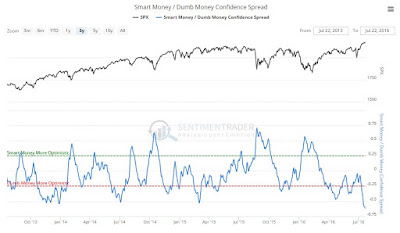 |
| Click for Larger View |
joshin4u: This data is an excellent resource provided by Sentimentrader.com.
Their write up below describes the indicator in more detail:
Threshold Return Analysis:
In order to provide more detailed information about our indicators, threshold return analysis has been performed for each. The below data describes the annualized returns for the underlying while the indicator value is above / below the extreme values as well as the returns of the underlying while the indicator is between the extreme values. Note that the returns provided are describing the periods that the indicator is only in the threshold region (e.g., above, between, below).
| Location of Indicator | Annualized Return | % of Time |
|---|---|---|
| Above Extreme | 15.0% | 17% |
| Between Extremes | 4.0% | 48% |
| Below Extreme | 3.0% | 35% |
Construction:
The Smart Money Confidence and Dumb Money Confidence indices are a unique innovation that allows subscribers to see, in one quick glance, what the "good" market timers are doing with their money compared to what "bad" market timers are doing.
Our Confidence indices use mostly real-money gauges; there are few opinions involved here. Examples of some Smart Money indicators include the OEX put/call and open interest ratios, commercial hedger positions in the equity index futures, and the current relationship between stocks and bonds. Examples of some Dumb Money indicators include the equity-only put/call ratio, the flow into and out of the Rydex series of index mutual funds, and small speculators in equity index futures contracts.
The Confidence Spread subtracts the Dumb Money from the Smart Money. So when the Spread is very high (above 0.25), that means the Smart Money is looking for a rally, and the Dumb Money is looking for a decline; we should expect stocks to rise after those conditions.
When the Spread is very low (below -0.25) then the Smart Money is anticipating a decline and the Dumb Money a rally; we should expect stocks to decline after that.
Note that the "dumb money" is not dumb at all during trends. Most of them are trend-followers, and will get more and more bullish as stocks rise. The "smart money" is mostly comprised of hedgers, and they will sell short as stocks rise. So for much of the time, it looks like we have the terms confused.
But it is when both sets of traders are at extreme positions that they earn their moniker. Dumb Money is most often at their most exposed before stocks decline, and at their least exposed before stocks rally; Smart Money is the opposite.
